Discuss your challenges with our solutions experts
5 reasons for Iraq's slow oil production growth
Harsh contract terms as well as technical, political, and security factors have kept production well below target
1 minute read
Remember Iraq's 12 million b/d oil production target? The country undoubtedly has the large-scale oil resources needed to reach this number, and the low costs required to attract companies actively repositioning lower down the cost curve. But harsh technical service contract terms and a myriad of technical, political and security factors have all conspired to subdue growth.
We have identified 10 commercial, technical, political and security constraints on Iraq's production growth, and discuss five of them here. For full analysis of these constraints, read our Insight report.
1. Technical Service Contract
The Technical Service Contract (TSC) promised quick cost recovery with a low per barrel fee, which should result in an acceptable IRR and a long-term steady income stream to offset the low net present value.
However, after several years a number of shortcomings are apparent. Oil makes up 90% of Iraq's government revenue, and following the oil price decline there were late payments to operators — which eroded project returns and demands to reduce capital expenditure — disrupting the schedule for investment projects.
2. Oil transportation
The TSCs gave responsibility to upstream operators for field development, but capacity for transporting oil to the offshore loading terminal has been constrained and largely remains the responsibility of Iraqi state enterprises. This has resulted in upstream growth outpacing midstream capacity.
3. Water supply for reservoir injection
Iraqi oil fields require large-scale water injection to achieve the expected recovery rates. For example, the Rumaila field is currently injecting close to one million b/d of water sourced from the Shatt al-Arab river to support a 60% recovery factor in the Main Pay. Other fields have more limited access to water supply, which could be problematic when long-term sustained production requires pressure support from water injection.

4. Rigs and drilling
Access to rigs and the number of drill days for wells are not a major constraint on production growth, but there are some instances where this is the case. At Rumaila, a well only takes 40 days to drill, while at Badra (which is developing a much deeper reservoir at 5,000 metres) exceeds 200 days, constraining production.
Looking to the future, rigs and drilling could become a much bigger constraint as reservoirs deplete and require more producer and water injector wells, and developments shift to deeper horizons with increased drill days.
5. Security/IS militants
Iraq is ranked as the highest risk country in the world, according to our sister company Verisk Maplecroft. Foreign companies operating in Iraq face a highly complex security environment, with terrorism constituting the most serious risk.
Indirectly, the cost of fighting IS militants has been a major reason why the government has struggled to meet scheduled oil payments and has called for investment to be slowed down.





